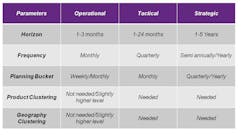How to Reduce Costs through Supply Chain Network Optimization
Supply chain network design is a powerful modeling approach proven to deliver significant reduction in supply chain costs and improvements in service levels by better aligning supply chain strategies. It incorporates end-to-end supply chain cost, including purchase, production, warehousing, inventory and transportation. While this is considered a strategic supply chain planning initiative, organizations can gain competitive advantage by running supply chain network scenarios, evaluating and proactively implementing changes in response to dynamic business scenarios like new product introduction, changes in demand pattern, addition of new supply sources, changes in tax laws and so on.
Supply chain networks have increasingly become global and dispersed. A variety of factors—ranging from cost structures, tax laws, skills and material availability, new market entry and others—have driven companies to redesign and reconfigure their supply chains continually. The consequent increase in complexity of market, channel, supply networks and distributed facilities has rendered related planning more intricate and complex.
Dedicated centralized supply chain teams have sprung up to help manage the complexities of global supply chain effectively. This article discusses the strategic needs around supply chain network design and the need to periodically make key strategic, tactical and operational decisions.
Companies have invested in processes, tools and resources to achieve efficiency and effectiveness through their supply chains. Many of them have migrated to an integrated planning approach with the objective of increased service level, responsiveness and on-time full delivery while judiciously balancing working capital needs. However such integrated planning often starts with an assumption that supply chain networks are static and tend towards driving optimization around the same. Since supply chains themselves are dynamic, supply chain network design exercises attempt to make supply chains agile enough to address current changes and future uncertainties.
The Why and When of Supply Chain Network Design
Companies have realized the importance of supply chain network design exercises but are still unable to make the best use of it. The challenge typically lies in selecting the right approach. Internal factors driving supply chain network design are focused on driving service delivery and working capital optimization across existing networks. As an example, inventory optimization exercises across the supply chain network focus on getting the inventory strategy right at each node of the supply chain using a customer-centric approach.
On the other hand, external factors also drive significant structural changes. For example, proposed tax reforms would provide a completely new strategy around supply chain network design and move to changes such as larger and more centralized warehousing facilities.
Internal Factors: Often, individual (function-specific) objectives and company objectives are not well defined or aligned. Different functions work on their individual objectives, often achieving local optimization while adversely impacting the overall supply chain performance.
As a result the costs associated with certain service levels could become a concern. Conflicting optimization objectives by functions lead to sub-optimal supply chain performance.
External Factors: Traditionally, businesses have established supply chains and different facilities across the network to gain tax benefits, trade concessions, labor arbitrage, capital subsidies, reduced logistics cost and customer proximity. Many of these factors can be impacted by political and economic policy changes, calling into question the relevance/optimality of the current supply network. In many cases, the impact of these changes is large enough to drive strategic structural supply chain changes. Preparing for such changes is important through use of strategic modeling and network design exercises.
Design Hierarchy
Supply chain decisions typically are taken at three levels: strategic, tactical and operational. At the strategic level, decisions typically link to business strategy and involve high investments, high change-over lead times and longer horizons. At the tactical level companies focus on adopting measures that focus on competitive needs, such as moving to a target cost structure for servicing certain markets. At the operational level the major focus is operational efficiency. Decisions are typically made on a day-to-day basis under the framework defined at strategic and tactical levels.
The figure below provides the hierarchy of supply chain needs addressed through such exercises and also typical questions that can be answered through the same.Lessons Learned and Best Practices
Supply chain network design and optimization exercises can be long and tiresome. It is important to have a pragmatic approach that delivers reliable results quickly and helps drive strategy into action. Some elements of this approach are:
Drive clarity of needs and wants: It is essential to evolve clarity in approach in any supply chain network design exercise. Each part of the optimization hierarchy has its own needs and requirements. A top-down approach may be needed if a comprehensive supply chain network design exercise is contemplated. It may be noted that the strategy phase typically provides a long-term framework in a time-phased manner, which acts as an input to tactical planning. Tactical planning decisions involve structural and operating policy decisions in a given supply chain model framework finalized in strategic planning.
The operational network design exercise uses the crux of strategic and tactical decisions and remains focused on the movement of products across the supply chain in a cost-efficient way. Operational planning is done on accurate figures and without minimal clustering at product and customer levels. Decisions can be made on a daily/weekly basis. The operating framework remains more or less the same and the KPIs are mostly operational KPIs of supply chains related to fill rate, out-of-stock, inventory turns, etc. The chart below lists some of the planning parameters for a leading consumer goods manufacturer.
Adoption of a Two-Stage Optimization Approach: A two-stage approach works well while carrying out a supply chain network optimization and design exercise. This is true across all parts of the decision hierarchy.
Funnel Approach:Most companies have to work with a multitude of product-, process- and facilities-related investment/divestment options in order to achieve the designed future target. This complexity leads to multiple scenarios being created. For faster results, it is important that the first stage of the network optimization exercise is targeted at limiting the number of scenarios to enable optimization. This can be done by using the KPIs set for a strategic network design exercise, such as investment cost, cost of ownership, return on investment etc.
Sensitivity analysis:Once we hit the zone of optimality, detailed what-if analyses should be done before finalizing the strategic recommendations, through multiple scenario analyses based on possible changes in demand size and shape, cost inflation and deflation, fiscal policy, and so on.
Simulation and “What If” Analysis: We recommend a simulation framework for testing small changes in parameters. This would result in better decision-making by the supply chain management teams. The simulation framework typically provides the statistical analysis around various key KPIs, simulating different scenarios with delta changes at the operational level.
Frequency of a Supply Chain Design and Optimization Exercise: While there are no clear answers to determine the frequency of such an exercise, it is important that companies review their key metrics and goals against existing supply chain networks periodically. Demand environment and supply side capabilities are not static, and doing an annual review on key operating needs like inventory needs, cost to serve channels/outlets, etc. is a good idea. In the eventuality of external triggers, the team needs to carry out preparatory exercises well in advance to accommodate long-term decisions and their lead time to implement.
Supply chain network design with a powerful modeling approach can deliver significant reduction in supply chain cost and improvements in service levels. It incorporates end-to-end supply chain cost: purchasing, production, warehousing, inventory and transportation. Companies can revisit their network periodically, considering changes in business scenarios like new product introduction, changes in demand pattern, regulatory changes and new supply sources so as to better align supply chain networks.
L.N. Balaji is the president of ITC Infotech (USA) Inc., a provider of end-to-end IT solutions, and heads the company’s operations in North America. Sandeep Kumar is the vice president at ITC Infotech and heads the business consulting group.






